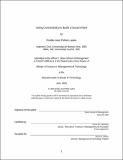| dc.contributor.advisor | James M. Utterback. | en_US |
| dc.contributor.author | Pellet-Lastra, Emilio José, 1959- | en_US |
| dc.contributor.other | Massachusetts Institute of Technology. Management of Technology Program. | en_US |
| dc.date.accessioned | 2005-05-19T15:36:02Z | |
| dc.date.available | 2005-05-19T15:36:02Z | |
| dc.date.copyright | 2003 | en_US |
| dc.date.issued | 2003 | en_US |
| dc.identifier.uri | http://hdl.handle.net/1721.1/16999 | |
| dc.description | Thesis (S.M.M.O.T.)--Massachusetts Institute of Technology, Sloan School of Management, Management of Technology Program, 2003. | en_US |
| dc.description | Includes bibliographical references (leaves 120-121). | en_US |
| dc.description | This electronic version was submitted by the student author. The certified thesis is available in the Institute Archives and Special Collections. | en_US |
| dc.description.abstract | Developed countries are increasingly using information technology to access and deliver information across all the organizations that comprise the government. Argentina is in the first stages of adopting Internet technology for the government. This thesis proposes that Argentina's e-government construction can be optimized if a good foundation for systems connectivity is put in place first. The author argues that the current time lag in the construction of Argentina's e-Government can be used in a positive way if experience from more developed countries is used. Chapter 1 provides a strategy for building e-Government in Argentina using standardization and connectivity. In Chapter 2, a theoretical analysis about the economics of systems integration is presented. In Chapter 3 the importance of standardization and specially the use of XML are outlined. Chapter 4 develops the basis of IT infrastructure and its importance to enable e- Government. Chapter 5 evaluates the current state of e-Government in three developed countries. Chapter 6 and 7 provide a potential framework for building the e-Government in Argentina based in the ideas of the previous chapters. The author has found that developed countries are defining standard connectivity based on XML and that they are in the process of becoming a full e-government by 2005. At the same time Argentina is lacking a coherent plan to enable the creation of the e-Government in the near future. Finally, the thesis proposes the standardization of systems interfaces using XML and the definition of standard XML data schemes to facilitate connectivity. At the same time the thesis encourages building an IT infrastructure and the use of standard applications to gain efficiency and lower the cost of e-Government. | en_US |
| dc.description.statementofresponsibility | by Emilio José Pellet-Lastra. | en_US |
| dc.format.extent | 121 leaves | en_US |
| dc.format.extent | 230594 bytes | |
| dc.format.extent | 230335 bytes | |
| dc.format.mimetype | application/pdf | |
| dc.format.mimetype | application/pdf | |
| dc.language.iso | eng | en_US |
| dc.publisher | Massachusetts Institute of Technology | en_US |
| dc.rights | M.I.T. theses are protected by copyright. They may be viewed from this source for any purpose, but reproduction or distribution in any format is prohibited without written permission. See provided URL for inquiries about permission. | en_US |
| dc.rights.uri | http://dspace.mit.edu/handle/1721.1/7582 | |
| dc.subject | Management of Technology Program. | en_US |
| dc.title | Using connectivity to build e-Government | en_US |
| dc.type | Thesis | en_US |
| dc.description.degree | S.M.M.O.T. | en_US |
| dc.contributor.department | Management of Technology Program. | en_US |
| dc.contributor.department | Sloan School of Management | |
| dc.identifier.oclc | 54107430 | en_US |
